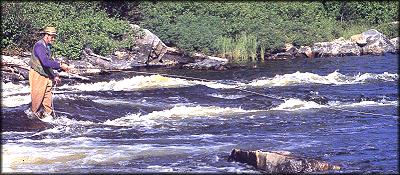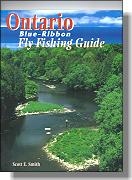Blue Ribbon Fly Fishing in Ontario, Part 4
Coastal Treasures - Techniques, Part 2
By Scott E. Smith
Excerpt from: Ontario, Blue-Ribbon Fly Fishing Guide
Published by: Frank Amato Publications, Inc.
P.O. Box 82112, Portland Oregon 97282 Phone: 503-653-8108,
email Frank Amato Publications
The wet-fly swing is also very effective in fishing coastal
streams; especially in the fall when the fish are more agressive
or when fishing water that holds brook trout, brown trout or
resident rainbow trout.
There are several ways to present a fly on a wet-fly swing;
however the techniques I will focus on here relate to the use
of sinking-tip and shooting-head lines.

Often when trout are deep, large rivers with heavy current
are not keyed in on any type of insect hatch, their holding lies
are near current seams created by structure, or the confluence of
conflicting currents. As the prime holding lies in these situations
are generally deep, the angler needs to present his fly deep. The
best method for swimming a large nymph or baitfish imitation in this
situation is on a fast-sinking portion of fly line - either a sinking-
tip or a sinking shooting head. Full-sinking lines are not
recommended for river fishing as they cannot be mended and are
difficult to handle in current. Fast-sinking portions of fly line
in small lengths (two, four and six feet) can be added to sink-tips
and shooting heads to increase their sink rate. These are known as
mini-tips. Unless you are fishing extremely clear water for very
spooky fish, a short leader, three to six feet long, is necessary
to maximize the effect of the sinking fly line. If your leader
is too long, the fly is lifted in the current, thereby defeating
the purpose of the sinking line, which is of course to get your
fly down deep.
Presenting a wet-fly swing with a sink-tip or shooting head
is made by making an across-stream cast, immediately mending slack
into the line (usually an upstream mend) to allow the fly to sink,
and then following the drift of the line (or swing) with your fly
rod. Imparting action to the fly with your rod tip will often elicit
strikes from hesitant fish.
The depth of the fly can be adjusted by casting farther upstream
if you want the presentation deeper, or by casting more downstream
if your presentation is too deep. Anglers that are very proficient
with this technique can often fish water that may be considered too
deep and fast for fly fishing. Experimentation with very fast sinking,
shooting-head lines - such as Scientific Anglers' Deep Water Express
series - has allowed fly anglers to effectively work stretches of
water once thought only fishable with spin-fishing techniques.

Casting sink-tip lines and shooting heads is quite a departure in style
from casting a floating line. When casting these heavy lines you
must slow your casting stroke down considerably. Use a side arm
motion on the back cast, wait for the line to straighten - fully loading
your rod - and then use an overhead motion on the forward cast,
deliver the line high, to allow for better trajectory and distance.
With some practice, casting distances of eightly to ninety feet
can be routinely accomplished with shooting heads and sink-tips.
Next time: Lake Superior Streams! ~ Scott E. Smith
Our Man In Canada Archives
|



